Just learned about the inaugural Great Maine Outdoor Weekend taking place this March 2-4, 2012. It’s being touted as a bi-annual celebration with a “series of events scheduled all across the great state of Maine to help connect [people] with the natural world, and promote fun, physical activity, and good health.”
Well, if that isn’t something that appeals to the Intrepid Pup’s sensibilities, we don’t know what will! Tavish isn’t in Maine this weekend to help celebrate, but he did spend the first 5½ years of his life in “Vacationland” living the state’s motto “Maine: The Way Life Should Be.” And in that time, he had ample opportunity to sample and enjoy some of the best trails, views and natural beauty the state has to offer. So, while this is by no means a comprehensive list, here are some of the Intrepid Pup’s top picks, by region, for getting out and about with your dog in Vacationland:
Dogging the Details
The three excursions described below all rank “2” on the Wag-a-meter as these are active, outdoor adventures with some pre-planning required. You’ll also be out-and-about pretty much the whole day with your dog, so be sure to pack along food/treats, water, and doggie bags.
MAINE BEACHES
43°20′51.32″ N, 70°28′50.92″ W
Kennebunk Beach, Kennebunk, Maine
If you’ve always associated Maine with craggy shorelines, there are plenty. But you might be surprised to learn that beautiful sandy beaches can be found in coastal towns throughout southern Maine. One favorite is Kennebunk Beach. At low tide, this crescent-shaped swath of sand extends out about a hundred yards before receding into the Atlantic Ocean. Then, if you could even see this far, the next land you’d spot would be Portugal. Seriously. The surrounding communities, collectively known as the Kennebunks, are tourist magnets (particularly in the summer and fall), but Kennebunk Beach holds a year-round allure even after temperatures for swimming and sun-bathing are but distant memories. The sidewalk follows the shoreline and is great for dog-walking, complete with several waste receptacles and doggie-bag dispensers. In fact, this same scenic route along the seawall is used by the area’s Animal Welfare Society for its insanely popular (and fun) annual “Strut Your Mutt” fundraiser.
Within certain hours, dogs are allowed ON the beach, too, provided you follow the regulations. Kennebunk Beach is a great spot for your dog to run, swim, and enjoy the company of the myriad other dogs and dog owners you’ll find. Do note that in the summer, nearby parking requires a beach permit.
Want to spend a full day exploring the Kennebunks with your dog? If it’s between June 15 and the day after Labor Day, time your romp on Kennebunk Beach to be either before 9 AM or after 5 PM. For the rest of the day, consider heading to Kennebunk’s very own dog park just a short drive from the beach up Sea Road. This fenced-in dog park shares an entrance with Kennebunk’s recycling center and is open daily from dawn to dusk. Still have energy to burn? From the dog park, go across Sea Road into the parking lot for Sea Road School. On the left-hand side, you’ll be able to access the trailhead for the Bridle Path, going southeast. Since it’s the former rail bed for the Boston & Maine Railroad from 1883, it’s pretty flat. For a little ways you’ll snake behind neighborhoods, but before long, you’re surrounded by woods and marshland. Keep your eyes peeled for glimpses of the Mousam River to the west; it’s a favorite for birders and kayakers. In this direction, the trail ends in about 2 miles at the junction with Western Avenue. Reward yourself and your dog for a day well-spent by heading into the heart of nearby Kennebunkport. In the heart of Dock Square, you’ll find Scalawags, a marvelous pet boutique, where a bowl of fresh water always awaits. Owner Mary Beth does a great job of sourcing tasty dog treats and an array of truly unique Maine-made and Maine-inspired wares (think rope leashes hand-crafted by Maine lobstermen!) for your four-legged friends. Extending your stay is always an option, and you’re in luck in that the Kennebunks are home to a number of pet-friendly accommodations like the Captain Jefferds Inn, the Colony Hotel, and the Hounds Tooth Inn.
GREATER PORTLAND AND CASCO BAY
43°39′02.59″ N, 70°11′41.37″ W
Peaks Island, Maine
Team Tavish dug back into the Intrepid Pup archives for this pic of an approximately 11-week-old Tavish on one of his very first trips to what would become a frequent destination: Peaks Island. Of the several hundred island communities that dot Casco Bay, Peaks is the most populous with ~1,100 year-round residents, though that number swells to 4,000+ during the summer months. Peaks is actually part of the City of Portland, but its history has been punctuated by various—and as yet, unsuccessful—secessionist movements. It’s accessible via a 15-minute ride from downtown Portland on the Casco Bay Lines ferry and is thus a popular day-trip destination. Vehicle traffic is minimal, with bicycles and golf-carts easily outnumbering cars on the roads. At just 2 miles long and about a mile wide, Peaks is both walkable and eminently picturesque.
Dogs are allowed on the ferry but do need their own tickets. Climb aboard and take a seat on the open-air top deck. It’s not uncommon to spot harbor seals en route. Once you arrive at the ferry landing on Peaks, walk up the ramp to Downfront, where you can fortify yourself with an ice cream cone. As you head out the door, hook a right to stay on Island Avenue and go back past the ferry landing, a little park, and a few restaurants. Within about 1/4 mile, the road will curve inland. Make a right on Whitehead and look for the short walking trail that leads down to Picnic Point and Hadlock Cove, where this photo of Tavish was taken. Here’s your craggy coastline and a stunning view of Casco Bay! If you bring along a picnic and a camera and never get any further in exploring Peaks, you won’t be disappointed. There is, however, much more to see. For a longer walk, rejoin the main road heading east, and within a few hundred feet you’ll come upon the Fifth Maine Museum. Its Memorial Hall cottage was constructed in 1888 as a memorial and reunion site for members of the Fifth Regiment Maine Volunteer Infantry (1861-1864) active during the Civil War. The museum’s exhibitions and programming cover regimental history and, more broadly, various facets of the island’s settlement. The museum is also playing a key role in the statewide sesquicentennial commemoration of Maine’s role in the Civil War. Heading right (east) from the Fifth Maine Museum, Seashore Avenue passes the 8th Maine Regiment building (now a lodge) and then quickly opens onto panoramic shoreline vistas. Seashore Avenue makes a circuit of the island and winds up being a little more than a 3-mile walk, ultimately reconnecting to Island Avenue, delivering you past the quirky, seasonally-open Umbrella Cover Museum and right back to where you started at the ferry landing. You can trim your overall distance by turning off Seashore Avenue onto any of the roads that bisect the island (see map). If you have time to spare before catching your return ferry, enjoy Shipyard Brewing Company beverages and a meal at the Inn on Peaks. When outdoor seating is available, your dog can join you on the patio.
MIDCOAST
44°13′22.91″ N, 69°04′07.73″ W
Mount Battie, Camden Hills State Park, Camden, Maine
Camden, Maine is a charming Midcoast town with quaint shops and inns, great seafood, schooner charters, and a bustling autumn Windjammer Festival that spotlights Camden’s picturesque marina. It’s also great base from which to undertake some hiking. Just over a mile outside the town center, heading north on Belfast Road/Route 1, is the main entrance on the left to Camden Hills State Park. The 30+ miles of trails are well-maintained and well-marked, but they do intersect one another frequently within the park’s 5,700 acres, so it helps to request a map at the ranger station and have a ranger suggest an appropriate route, based upon the time you have available.
A favorite of Team Tavish is the Mount Battie Trail, which is accessed from the parking area just beyond the ranger station. While the trail isn’t technically challenging (heck, it even crisscrosses the auto road to the summit, but driving up would be “cheating”!), it’s a lovely couple miles of walking in the woods, and the payoff is huge. The trail tops out at a smooth rock outcropping 780′ above sea level with a breath-taking view of Camden Harbor immediately below and Penobscot Bay beyond. In autumn, leaf-peeping and spotting the migrating hawks are additional draws. For a longer foray, daisy-chain the trails and try out Bald Mountain (1200′), Mount Megunticook (1385′), or Maiden Cliff (800′).
Word has it that the next Great Maine Outdoor Weekend is already slated for September 28-30, 2012. Stay tuned for the Intrepid Pup to share more of his favorite Maine excursions then!


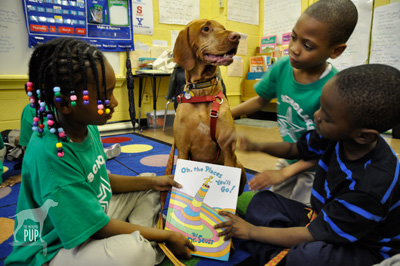 A 1st grader peeped his head around the door, turned back to his classmates and proclaimed, “Hey! The dogs are here!”
A 1st grader peeped his head around the door, turned back to his classmates and proclaimed, “Hey! The dogs are here!”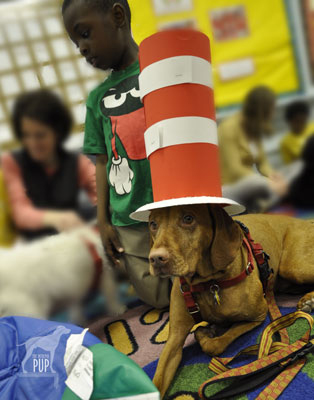 The classrooms were hives of activity. 130 kindergartners through 5th graders could barely contain their excitement. Tavish’s role, along with five other dogs, was to “help” with the final after-school activities of the day. Tables were cleared to make way for scissors, staplers, paper plates and construction paper. The result? “Cat in the Hat” hats, of course! And then, armed with Dr. Seuss bookmarks, there was the chance to choose from an array of Dr. Seuss storybooks. Grinning from ear to ear, young Cheyenne
The classrooms were hives of activity. 130 kindergartners through 5th graders could barely contain their excitement. Tavish’s role, along with five other dogs, was to “help” with the final after-school activities of the day. Tables were cleared to make way for scissors, staplers, paper plates and construction paper. The result? “Cat in the Hat” hats, of course! And then, armed with Dr. Seuss bookmarks, there was the chance to choose from an array of Dr. Seuss storybooks. Grinning from ear to ear, young Cheyenne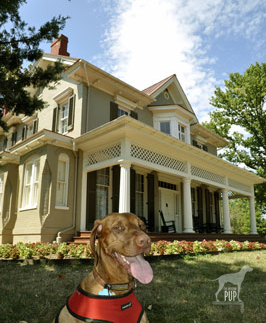 February is
February is 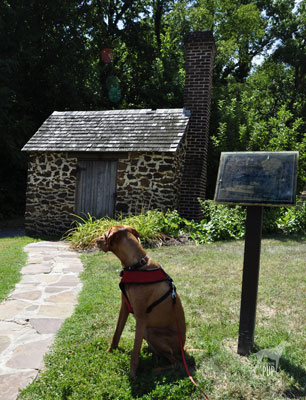 On the day of our visit, we had an exceptionally knowledgeable and engaging young ranger. He deftly hit the highlights of Douglass’s public life but also gave insights into Douglass’s more personal side, pointing out Douglass’s extensive library, the violin he played, and the free weights he used to maintain his personal fitness. Referencing the various portraits throughout the house, the park ranger expounded upon Douglass’s social circle and relationships with abolitionists William Lloyd Garrison and John Brown; Presidents Lincoln, Grant, Hayes and Harrison; Underground Railroad champion Harriet Tubman; and abolitionist and suffragist Elizabeth Cady Stanton. He explained the importance of Douglass’s family life and—after wife Anne’s death in 1882—controversial second marriage in 1884 to Helen Pitts, a white woman and women’s rights activist and publisher. And we learned-lesser known details, such as Douglass’s appointments as Charge’ d’Affaires for Santo Domingo and as Minister to Haiti. Before departing, we checked out the rustic outbuilding at the rear of the property. It’s a reconstruction of Douglass’ self-proclaimed “Growlery.” Evocative of a lion’s lair, it served as Douglass’ personal retreat for writing and study.
On the day of our visit, we had an exceptionally knowledgeable and engaging young ranger. He deftly hit the highlights of Douglass’s public life but also gave insights into Douglass’s more personal side, pointing out Douglass’s extensive library, the violin he played, and the free weights he used to maintain his personal fitness. Referencing the various portraits throughout the house, the park ranger expounded upon Douglass’s social circle and relationships with abolitionists William Lloyd Garrison and John Brown; Presidents Lincoln, Grant, Hayes and Harrison; Underground Railroad champion Harriet Tubman; and abolitionist and suffragist Elizabeth Cady Stanton. He explained the importance of Douglass’s family life and—after wife Anne’s death in 1882—controversial second marriage in 1884 to Helen Pitts, a white woman and women’s rights activist and publisher. And we learned-lesser known details, such as Douglass’s appointments as Charge’ d’Affaires for Santo Domingo and as Minister to Haiti. Before departing, we checked out the rustic outbuilding at the rear of the property. It’s a reconstruction of Douglass’ self-proclaimed “Growlery.” Evocative of a lion’s lair, it served as Douglass’ personal retreat for writing and study.

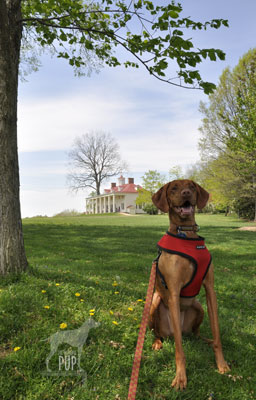 “First in war, first in peace and first in the hearts of his countrymen….”
“First in war, first in peace and first in the hearts of his countrymen….”









